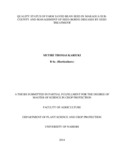| dc.description.abstract | Common bean (
Phaseolus vulgaris
L
.) is the leading food l
egume widely grown in the world. In
Kenya, beans play an important role of sustainable livelihood to millions of small scale fa
rmers
through provision of food security and income. However, farm saved bean seed is an important
source of disease
inoculu
m for major bean diseases thus contributing to low bean production
among small scale farmers.
The overall objective of the study was
to contribute to increased bean
productivity through production of quality seed and reduction of seed
-
borne diseases by seed
treatment.
A survey to determine bean production practices was conducted in diverse agro
-
ecological zones of Muragua, Murang`a Cou
nty. Samples of
farm
-
saved
bean
seed
varieties
were
collected from the farmers and analyzed for physical purity,
germination
and pathogens
contamination
.
In addition, field experiments were conducted over two cropping seasons at
Kenya Horticulture Research
Institute Research
(KA
LRO
),
Thika
to evaluate the efficacy of
seed
treatment chemicals
in the management of root rot fungi
and
seed
-
borne
bacterial blight
. The
seed trea
tment options evaluated were
Seed plus®
(ii)
Apron star® 42 WS
,
Rootgard®
,
Funguran
–
OH 50WP®
,
Cruiser Maxx®
,
Monceren® 125
. Data was collected on
stand count,
incidence of root rot
, bean stem maggot infestation, common bacterial blight incidence and seed
yield.
The study showed that beans are produced in small holdings of less than one
acre and most
farmers use uncertified farm
-
saved seeds.
Farmers were found to grow a mixture of different
bean varieties and root rots and bacterial blights were the commonly cited diseases. Very few
farmers used chemicals during bean production to control
pests and diseases. Only a few farmers
from lower midland zone four (LM 4) reported relatively higher bean grain yield compared to lower highland zone one (LH 1) and upper midland zone two (UM 2). Most of the farm
-
saved
bean seeds had less
than
the 9
5% re
commended
physical purity and contained high levels of
discoloured and bruchid damaged seeds.
Some of the samples met the required minimum
germination percentage
of
80%. The samples from different agro
-
ecological zones differed in the
level of contaminatio
n with fungal and bacterial blight causing pathogens. Samples from agro
-
ecological zone
(
LH 1
)
had higher contamination levels.
Seed treatment with chemicals
significantly improved
seed emergence and the stand count.
Seed treatment with
Cruiser Maxx®
,
Monc
eren® and
Apron star® 42 WS
significantly reduced
incidence
of bean
stem maggot
(
Ophiomyia
s
pp
.
).
Certified seeds treated with
Apron star® 42 WS
significantly reduced
infection with
Rhizoctonia
solani
,
Fusarium
phaseoli
and
Macrophomina
phaseoli
compared t
o
non
-
treated seeds
.
Variety Wairimu dwarf had lower incidence of both root rot and common
bacterial blight compared to Rosecoco (GLP 2). Seed treatment also resulted in
significant
increase
in grain yield. The study showed that the low bean yields among t
he small scale farmers
in Maragua sub
-
county can be attributed to the prevalent use of u
ncertified farm
-
saved bean seed
and
low usage of farm inputs such as pesticides and fertilizers. The farm
-
saved seed was of low
quality resulting in low germination, po
or
crop stand, increased incidence
of diseases and low
yields. However, seed treatment can effectively manage root rot and foliar diseases and
therefore, improve yields. | en_US |

